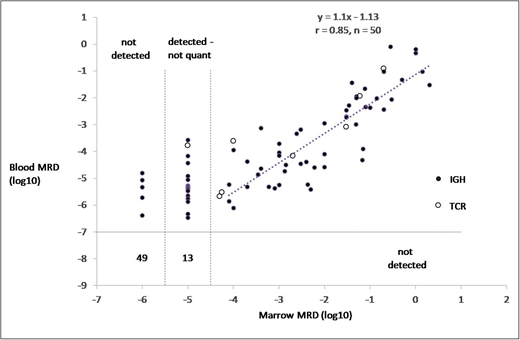Abstract
Measurement of MRD in samples of marrow is widely used for managing patients with ALL but the clinical utility of current methods is limited by their lack of sensitivity. The limit of detection of current quantification by PCR or flow cytometry is 10-4 - 10-5 and quantification is less precise at lower levels. Improving the sensitivity of MRD assays could enable use of peripheral blood instead of marrow, facilitate decisions on whether to change therapy and improve assessment of novel therapies.
We have developed a new, highly specific and hence highly sensitive PCR method to quantify MRD in ALL. Blood and marrow samples were obtained at diagnosis and during treatment from adolescents and young adults aged 15 - 40 who entered study ALL06 of the Australasian Leukaemia and Lymphoma Study Group. The Sutton laboratory measured MRD in 1.5 µg of marrow DNA using RQ-PCR according to Euro MRD guidelines and provided the sequences for the VDJ regions of the rearranged immunoglobulin heavy chain (IGH) and T-cell receptor β-chain (TRB) genes. The Morley laboratory developed HAT-PCR and used it to quantify the IGH or TRB rearrangement in blood samples. The forward PCR primer was directed to the VDJ region, had a Tm of 69 -75 oC, and the sequence was designed to minimise non-specific priming. The reverse primer was directed to the J region and was also designed to minimise non-specific priming. The PCR was performed using an annealing temperature of 72 - 77 oC. Specificity for each primer was tested using at least 20 µg of non-leukemic template DNA. Quantification of patient samples was performed using up to 30 ug of template DNA, the amount being determined by a preliminary assay and by the amount of DNA available.
Using DNA from 14 patients, the accuracy of HAT-PCR was assessed by assaying tenfold dilutions, between 10-3 and 10-6 , of each leukemic DNA in nonleukemic DNA. The correlation between observed and expected values was 0.98 and the regression line had a slope of 1.00.
The precision of HAT-PCR was measured by using DNA from 10 patients, making multiple dilutions in nonleukemic DNA, assaying up to 30 µg of DNA from each dilution twice, on 2 separate days, and calculating the standard deviation (SD) of the assay. For 69 paired assays the SD ranged from 0.05 logs at a dilution of 10-3 to 0.31 logs at a dilution of less than 10-6. The increase in SD at low levels reflects the stochastic Poisson effect observed when the number of target molecules is low.
Primers were designed for 47 patients. Non-specificity was not seen with primers for 43 patients, a negative finding which indicated that non-specificity was below 3.35 X 10-7. Non-specificity was seen with primers for 4 patients, with levels corresponding to 3.35 X 10-7, 6.70 X 10-7, 6.70 X 10-7 and 4.36 x 10-6. The rearrangement in all 4 was a partial DNJ rearrangement with only 3 or 4 bases in the N region. To date,141 paired blood and marrow samples from 40 patients with ALL have been studied. Results are shown in the Figure. HAT-PCR quantified MRD down to 3.35 X 10-7 and for IGH rearrangements there was good correlation between levels in blood and marrow. Much of the variation between blood and marrow is likely to be due to the sampling error of marrow aspiration. For IGH rearrangements, the mean ratio between marrow and blood levels was 20 but, as marrow assays were done on separated mononuclear cells whereas blood assays were done on total cells, the true ratio is probably closer to 10. The greater sensitivity of HAT-PCR appeared to compensate for the lower levels in blood and, in quantitative terms, assay of blood appeared to be non-inferior to assay of marrow. Data on patient outcomes are not yet available.
Conclusions
Measurement of MRD by HAT-PCR is approximately 2 logs more sensitive than measurement by conventional RQ-PCR or flow cytometry.
When applied to marrow, HAT-PCR has the potential to improve assay precision for some patients with currently detectable MRD and to detect and quantify MRD levels in some patients with currently undetectable MRD. These features should facilitate identification of patients who are candidates for intensification or reduction of therapy and should improve assessment of new therapies.
When applied to blood, HAT-PCR has the potential to predict patient outcome and to follow patients to detect impending relapse.
HAT-PCR should be applicable to quantification of MRD in other lymphoproliferative disorders.
Morley:Monoquant P/L: Equity Ownership, Membership on an entity's Board of Directors or advisory committees, Patents & Royalties, Research Funding. Latham:Monoquant P/L: Equity Ownership, Research Funding. Hughes:Monoquant P/L: Equity Ownership, Research Funding. Budgen:Monoquant P/L: Equity Ownership, Research Funding.
Author notes
Asterisk with author names denotes non-ASH members.


This feature is available to Subscribers Only
Sign In or Create an Account Close Modal